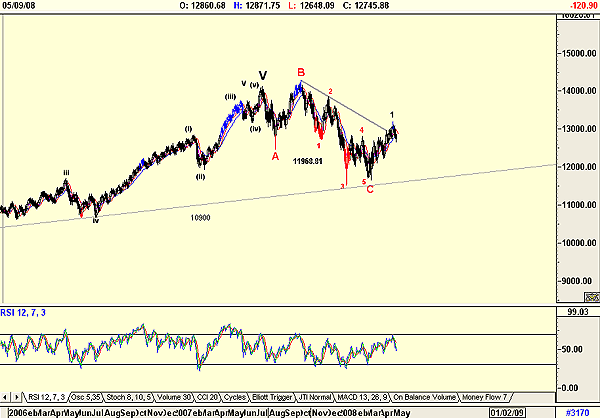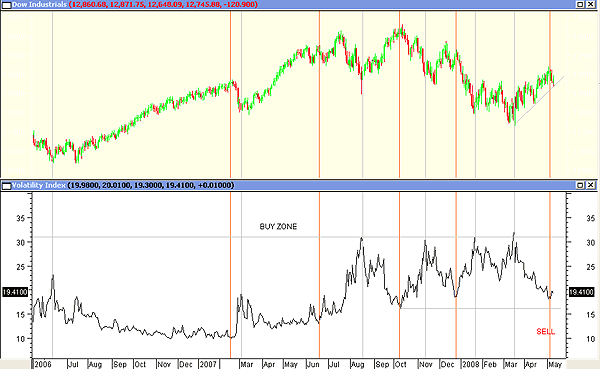
HOT TOPICS LIST
- MACD
- Fibonacci
- RSI
- Gann
- ADXR
- Stochastics
- Volume
- Triangles
- Futures
- Cycles
- Volatility
- ZIGZAG
- MESA
- Retracement
- Aroon
INDICATORS LIST
LIST OF TOPICS
PRINT THIS ARTICLE
by Koos van der Merwe
Is the VIX now telling us to be prepared?
Position: N/A
Koos van der Merwe
Has been a technical analyst since 1969, and has worked as a futures and options trader with First Financial Futures in Johannesburg, South Africa.
PRINT THIS ARTICLE
ELLIOTT WAVE
What Is The VIX Telling Us?
05/14/08 01:54:33 PMby Koos van der Merwe
Is the VIX now telling us to be prepared?
Position: N/A
| In spite of what the pundits interviewed on CNBC are telling us, it has become a matter of "Is it or is it not a recession?" Charts, as I have previously said, have convincingly confirmed that the US is very definitely in a recession, and has been in one since October 2007. Figure 1 is of the Dow Jones Industrial Average (DJIA) and starting to suggest that the recession — the down move may well be over. The chart shows that the DJIA has completed an ABC correction, and could now be tracing a wave 1 of a new bull market. If this is so, does this mean that the US recession is over? |

|
| FIGURE 1: DJIA, RSI. A wave count of the DJIA with RSI. |
| Graphic provided by: AdvancedGET. |
| |
| Not yet, and for two reasons. The first is the relative strength index (RSI), which has not reached oversold levels, and suggests that wave 1 could still be in progress. The other is that although the VIX is approaching levels where previous DJIA buy signals have been given, a turn has not been cast in stone. This could only be the case if the DJIA breaks below the short-term trendline drawn on the chart. After a wave 1 up, there is always a wave 2 down, and the VIX chart below is suggesting that the DJIA is about to fall in a wave 2. It has become not a matter of when, but a matter of soon. |

|
| FIGURE 2: DJIA, VIX. A chart of the DJIA and the VIX showing buy and sell zones. |
| Graphic provided by: MetaStock. |
| |
| Figure 2 is that of the VIX and the DJIA. On the chart I have drawn gray vertical lines when the VIX has spiked up, and red vertical lines when the VIX has spiked down. It is obvious just by looking at the chart that when the VIX is high, the DJIA falls, and when the VIX is low, the DJIA rises. Admittedly, the signals are not exact in that they do not pick up the exact turning point, but the signals given by the VIX are more than good, and have proved that they should be obeyed. Figure 2 shows that the VIX is now signaling that a sell of the DJIA is on the cards, if not soon, then in the not-too-distant in the future. With the maxim "Sell in May and go away" on everyone's mind, this could be the trigger initiating the fall. You, the investor, should sit back, hold your cash, and wait. For how long? Well, a wave 2 correction can be complex or simple. If simple, then wave 4 will be complex and vice versa, so the timing could be longer or shorter than anticipated. What one does know, however, is that a wave 2 is usually a 72% correction of wave 1, and that the majority of investors and the pundits always believe that it is a continuation of the downtrend and preach doom and gloom. So being in the know, sit back and wait — and follow the advice given by every Boy Scout, which is "Be prepared," and stay in cash for now. |
Has been a technical analyst since 1969, and has worked as a futures and options trader with First Financial Futures in Johannesburg, South Africa.
| Address: | 3256 West 24th Ave |
| Vancouver, BC | |
| Phone # for sales: | 6042634214 |
| E-mail address: | petroosp@gmail.com |
Click here for more information about our publications!
Comments
Date: 05/16/08Rank: 3Comment:
Date: 05/16/08Rank: 5Comment:

|

Request Information From Our Sponsors
- StockCharts.com, Inc.
- Candle Patterns
- Candlestick Charting Explained
- Intermarket Technical Analysis
- John Murphy on Chart Analysis
- John Murphy's Chart Pattern Recognition
- John Murphy's Market Message
- MurphyExplainsMarketAnalysis-Intermarket Analysis
- MurphyExplainsMarketAnalysis-Visual Analysis
- StockCharts.com
- Technical Analysis of the Financial Markets
- The Visual Investor
- VectorVest, Inc.
- Executive Premier Workshop
- One-Day Options Course
- OptionsPro
- Retirement Income Workshop
- Sure-Fire Trading Systems (VectorVest, Inc.)
- Trading as a Business Workshop
- VectorVest 7 EOD
- VectorVest 7 RealTime/IntraDay
- VectorVest AutoTester
- VectorVest Educational Services
- VectorVest OnLine
- VectorVest Options Analyzer
- VectorVest ProGraphics v6.0
- VectorVest ProTrader 7
- VectorVest RealTime Derby Tool
- VectorVest Simulator
- VectorVest Variator
- VectorVest Watchdog
